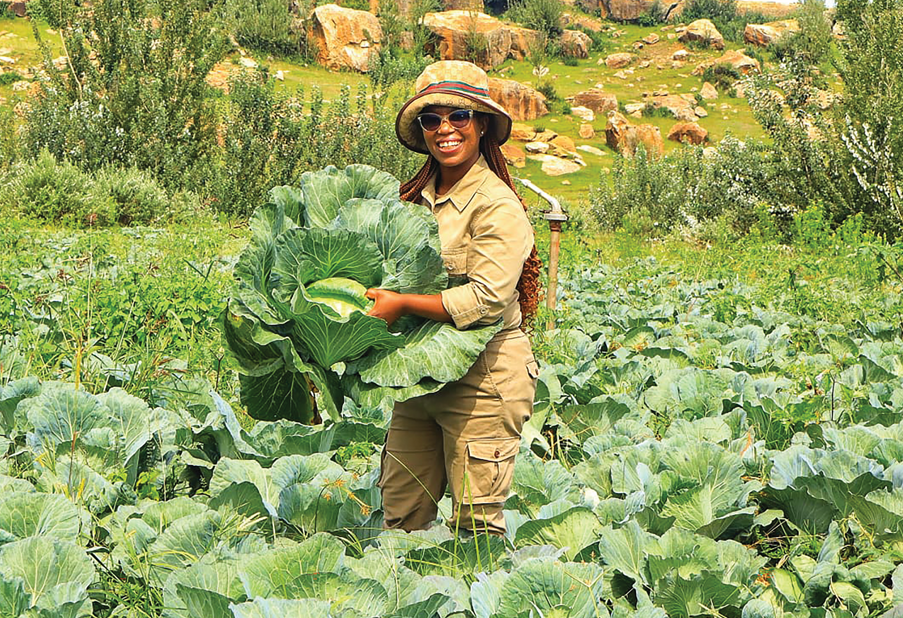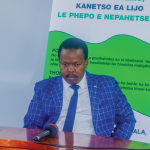![]()
In the fields of Lesotho, where many farmers till the soil with hope in their hearts but struggle with thinning yields and tired land, the idea of regenerative agriculture might seem distant, maybe even unfamiliar. Yet, it may be the very key to reviving the health of the land, the stability of rural livelihoods, and the future of food in the country.
Regenerative agriculture, according to experts, isn’t just a technical set of practices; it’s a mindset shift, one that invites farmers to work with nature instead of against it.
In Lesotho, where steep terrain and overused soil often lead to erosion and crop failure, this kind of farming is not a luxury; it’s a necessity, experts warn.
Years of monoculture, overgrazing and excessive ploughing have stripped the soil of nutrients and robbed communities of food security. As agronomist and soil health expert Dr. Botle puts it, “The loss of organic matter in Lesotho’s soils has reached a critical point. Without urgent intervention, our farmlands may soon become barren. Regenerative agriculture can reverse this decline and restore life to the land.”
Around the world, this movement is gathering pace.
A 2021 report by the Africa Regenerative Agriculture Study Group projects that if adopted across sub-Saharan Africa, regenerative methods could generate over M273 billion in added value by 2030, and up to M1.2 trillion by 2040 —while creating almost five million jobs along the way.
These numbers are promising, but the more powerful truth lies in the stories of farmers already leading the shift, including a few right here at home.
After the devastating 2015 drought, a farmer named Thapelo Phiri in QwaQwa, South Africa, turned his back on chemical-intensive farming and began to explore regenerative practices.
“It felt like I was healing something, not just the soil, but myself,” he reflects.
That same sense of renewal inspired Matente Khethisa, a local farmer from Leribe, who spoke at the 2nd Roundtable of African Farmers in Rome in 2024.
Representing Lesotho, she challenged the idea that regenerative farming is a foreign or modern concept. “We have always had these tools: compost, manure and crop diversity. We just stopped valuing them,” she said.
Her point is echoed across the continent, where farmers using agroforestry, mulching, and composting are beginning to turn depleted plots into thriving, biodiverse farms.
In other parts of Africa, farmers are already seeing transformative results.
In Ethiopia, coffee farmers tripled their yields using shade trees and pruning methods.
In Côte d’Ivoire, cotton farmers increased their harvest by 80% through crop rotation and mulching.
Ghanaian cocoa farmers improved yields by over 60% while restoring over 250,000 hectares of forest. These aren’t experimental projects but real examples captured in the report, showing that soil can be brought back to life when farmed with care.
Khethisa said for Basotho farmers, the path to regenerative agriculture doesn’t need to begin with sweeping change.
“It can start small, with one plot, one season. Composting kitchen scraps, rotating maize with beans, or reducing how often the land is ploughed. This all can make a difference.
She added, “Using what’s already available — like animal manure or crop residues — cuts costs while building healthier soil.”
The report noted that even practices like raised beds or tunnel farming, which may seem simple, can conserve moisture and prevent erosion in mountain communities.
“The benefits go far beyond the farm gate,” the report said.
The report stressed that scaling regenerative agriculture could boost national crop production by 13% and food consumption by 24% by 2040, meaning more food in homes, less reliance on expensive imports, and lower household vulnerability.
Environmentally, the report continues saying these practices could lock away six gigatons of carbon in soils and trees, playing a vital role in fighting climate change.
“…And financially, African farmers could save up to M309 billion a year in reduced input costs by 2040.”
But to make this shift meaningful and lasting, Khethisa indicated that Lesotho needs more than a few model farmers. The system itself must adapt.
She challenges that the National policy must embrace regeneration, integrating it into extension services, land reform, and climate strategies.
“Financial support, whether in the form of subsidies for compost or microloans for tunnel farming, can ease the transition for Basotho farmers,” the farmer said.
She challenged that schools and universities must begin teaching these approaches, not just to future farmers but to policymakers, economists, and scientists.
Some tools already exist to support this shift in the country includes the Lesotho Soil Information System, which was launched in 2020.
It offers detailed insights that can help guide crop choices and farming methods across districts. But data means little if not paired with real-world training.
That’s where farmers like Geoff Johnson, a retired commercial farmer and regeneration consultant based in the Free State, step in. Although he no longer farms, he now dedicates his life to helping others transition.
“We must move away from chemicals and back to life. It’s not just about techniques. It’s about how you see and treat the land. The future of farming lies in regeneration, not destruction,” he said.
Johnson, Khethisa, and Phiri all agree on one thing: the shift must begin in the mind before it takes root in the soil.
“Start small. Try one new thing. One row of cover crops. One compost pile. And watch. Nature teaches best.” Khethisa said, encouraging Lesotho’s farmers to form learning circles, to share both failures and victories, and to tailor practices to the country’s varied terrain and climate.
“Whether it’s rotating crops with legumes, planting trees that hold soil on slopes, or conserving water with mulch, each action plants a seed for a different kind of agriculture.”
She highlighted that the challenges are real.
“Fertiliser companies won’t easily give up their markets, and many farmers still measure success by volume, not resilience. But the momentum is growing. As more farmers across Africa see regeneration not as a sacrifice, but as an opportunity to build something lasting, Lesotho stands at a critical crossroads,” she said adding that what is needed now is belief that soil is not dead, that farming can be both productive and respectful, and that the answers sought after have often been right beneath farners feet all along.
“Regenerative agriculture may not be fully understood yet in Lesotho, but its principles are deeply familiar: care, observation, balance, and hope,” Khethisa concluded.
As Phiri echoes, “Once a farmer believes the soil is alive and not just dirt, everything changes.”




